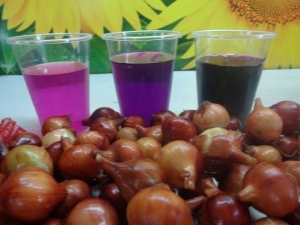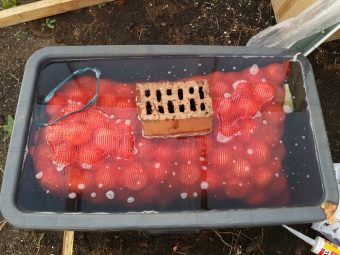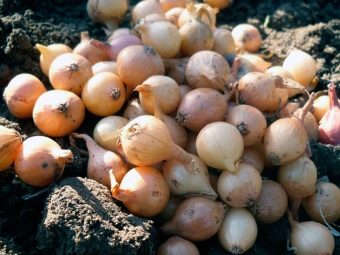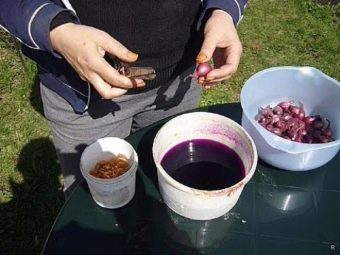Peculiarities of onion processing before planting with potassium permanganate and salt

There is an opinion that growing onions is very simple: without a bush and leaf plate, he is not able to respond to external stimuli. Here, the main thing is watering, the sun, the periodic removal of weeds. Yes, and the harvest can not be a win-win, because the green growth of the crop will still give.
But an experienced gardener knows that at the most minimal cost of effort and finances the harvest can be significantly improved. Even the same green shoots will not be too early to let the arrows, preserving as long as possible the freshness of the young green onion - leek. And besides, with good greenery, you can save elastic bulbs, suitable for food.
Features of growing
Onions - a fairly unpretentious plant, the cultivation of which is not difficult. As they say, "stuck in the ground and forgot." Many believe that growing onions, the main thing - to water and pull the weed. But with such an attitude towards the cultivated crop, its yield may disappear altogether or be a surprise. And onions in such cases occupies a leading position.
It is not uncommon for gardeners to plant crops in order to get onions, but to get leeks and vice versa. It would seem that the loss is small, if you do not grow crops on an industrial scale. But the secret is that with a consciously correct approach to growing yields can be significantly improved, even for personal needs. And otherwise - to destroy at all. The same leek, which is the easiest to grow, with the wrong care can start early to turn the hands, becoming tough, completely unsuitable for use in raw form.
In order not to be disappointed in your expectations at harvest time, we recommend deciding on the final result before planting: you still need onions or prefer leeches. Proceeding from our needs and from the planned yield scales, we proceed to the selection of seeds and preparing the soil.
Preparing for landing
It is no secret that onions can be planted both in spring and autumn. Autumn planting is, in contrast to the spring, more troublesome, because it involves insulation for the winter. But she already allows in early spring to get a fresh onion leek. Well, it would seem that it may be easier to simply plant an onion in the spring: sevok, unlike other seeds, is quite large in size, making it possible to see the flaws, and in almost any store is sold freely available.
In addition, the spring planting does not involve any special troubles associated with warming, since the spring-summer thermal time is quite enough for the crop to grow and ripen. For example, if the winter was snowy, then there is also nothing to worry about, since for winter crops the snow plays the role of "insulation". But if winter is snowless or snowless, then the crop you sow without additional insulation just freezes.
Despite the ease of growing bulbous plants, we still recommend preparing the seedbed preparation of onions before planting, which will allow you to avoid early yellowed feathers or the appearance of a soft and sluggish bulb during harvest. First, you need to carefully consider sevok for signs of decay.
The rotted or slightly soft onions are unsuitable for sowing, as they not only cannot produce good crops themselves, but they can also develop fungal diseases, even contamination of the soil, as well as the appearance of pests (bulbous fly). Secondly, it is necessary to remove, at first glance, a trifling, weakly sitting onion peel, which can also cause the appearance of diseases or pests.
If the seeds are domestic, then the measures described can be completely limited. But, buying seeds in stores or from neighbors, it is useful to carry out the treatment in the form of soaking in a special self-prepared solution. This will certainly help to improve the future harvest and avoid serious problems during the growing period.
The contaminated soil mentioned above can cause the loss of any crop in a certain area for several years. In order to avoid such an infection, it is necessary every year to plan planting in the garden, annually changing the place for garden for one or another plant. Onions, for example, grow well after carrots or tomatoes.
After onions, due to the nature of the soil, not everything can be planted. Here a good harvest will give only a turnip. In this way, Pre-treated seed bulbs have a favorable effect not only on the harvest, but also on the soil, enabling the favorable cultivation of a different crop after it.
Processing with potassium permanganate and salt
After selecting the best, dense seeds and removing unnecessary hanging husk, it is possible to soak the seedlings for three hours in an aqueous saline solution. The solution is prepared at the rate of two tablespoons of salt without a hill (having typed a full spoon, we run a finger along its edges, then it will be exactly a spoon without a slide) for two liters of water. Salt can be taken any that is available in the house: large, small, iodized. Dissolve it in warm, but boiled water. Immerse sevka in cooled to room temperature water after complete dissolution of the salt.
So you need to handle any seedlings purchased in unknown stores or with it. Although it will not be superfluous to process the “home” set, which will ensure its rapid development and good growth. In addition, the salt solution protects the plant in the future from nematodes (roundworms that can harm both the plant and man).
If you live in a region with enough warm days for onion growth and you are not interested in the process of accelerating growth, you can soak the seedlings only in a well-known solution of manganese disinfectant. In order not to burn the ovaries of future roots, here it is necessary to adhere to the following dosage: approximately 10 grams of potassium permanganate is taken for 10 liters of water. Keeping sevka in a solution of an hour or two is quite enough to carry out the disinfection procedure.
Potassium permanganate is also dissolved in boiled, but cooled water. Sevki immersed in water, only reached room temperature. To achieve the greatest effect, it is recommended that experienced gardeners make small cross-shaped cuts in the sevka through which the solution can penetrate as deeply as possible. But here, the main thing is not to overdo it with the cuts. For newcomers to the field of cultivation, it’s better not to make cuts
Particularly enterprising and cautious gardeners manage to combine procedures. First, the bulbs are soaked in saline for one and a half hours, after which they are immersed in a solution of potassium permanganate. But it is not recommended to keep them there for a long time (approximately 30 minutes), since the primordia “burn out” from oversaturation.
Pros and cons of soaking
Nowadays, many new ways and means have appeared for activating plant growth and for preventing the appearance of various diseases and pests. To listen to folk remedies or not is an individual decision of everyone. Nevertheless, all gardeners agree that it is easier to prevent problems than to get rid of them. The advantage of these procedures can be considered their general availability: everyone has salt with manganese, and it is easy to soak the seeds in the solution. Experts gardeners, having tried the marked procedures in practice, note the following advantages:
- there is a parallel development of the bulbs and greens, that is, having received a good harvest of greens, you can not worry that the bulb will be sluggish, unfit for human consumption;
- Sevka disinfected in manganese solution is less likely to get sick, having developed immunity to pests and sudden temperature changes;
- we can say that the soil after planting the treated sevka is protected from diseases transmitted with the seeds, because the rotting process has been prevented.
In addition, it is noted that when improperly conducting the soaking procedure in both salt and manganese solutions, the following inadequacies of inoculum are observed:
- Sevka begin to deteriorate rapidly, acquiring uncharacteristic softness for them;
- Signs of decay are visible at the site of the formation of the root system.
Some consider the aforementioned deficiencies to be an error in the execution of the soaking process, and others are disadvantages of this procedure. It often happens that soaking does not bring proper results, especially if it is carried out by novice gardeners. In this case, do not get upset, because the experience is gained over time, and the next time everything can turn out much better.
To avoid trouble during soaking, you need to take into account all the subtleties, as well as seek advice from those who are not the first time.
Tips experienced gardeners
If the region where you live is characterized by frequent rains and, as a result, dampness, then preliminary treatment of seeds, which stimulates the production of immunity, is simply necessary. In order not to treat the plant in the future, we recommend that you perform pre-sowing treatment, which is absolutely harmless for future harvest. We are talking about the features of the processing of salt and manganese solution.
So, so that the seals are not spoiled, you should not keep them in the prepared solution for a long time, because they can rot. Two hours are enough for saline, and one and a half hours is enough for manganese. Try not to overdo it with salt or potassium permanganate, because the ovary of the root system can “burn” without even appearing.
If you plan to conduct combined procedures, the time spent on them should not exceed two hours. For a salt solution, it is preferable to set aside an hour and a half, and thirty minutes is enough for potassium permanganate, since salt not only activates growth, but also has a less pronounced disinfecting effect. Remember that over-saturation of any plant with anything may be at times more destructive than its disadvantage.
After the planned procedures are completed, the bulbs are gently washed and planted in the previously prepared heated earth. Soaking is performed only before direct planting. Otherwise, you will not get the desired result, because disinfecting the seed lines and leaving them for a few more days in ordinary water, you will again throw them into the “bacterial environment”. The solution for immersing the seed set must be freshly prepared, otherwise bacteria harmful to the seeds may also form in it.
Another point that should not be forgotten: seed pretreatment is recommended only before spring planting. Sevok, saturated with moisture of an aqueous solution and immersed in the earth, well heated by the sun, is quickly accepted and, strengthened, begins to grow. It is highly undesirable to carry out such a procedure before the autumn planting, since you immerse the onions saturated with moisture in the ground, which will not insulate every day, but rather freeze through.
This may well lead to freezing of seeds (planting for the winter takes place approximately in September – October). Although experienced gardeners who know the climatic features of their region and who know how to orient themselves in the thermal features of the soil, as well as in terms of rooting seedlings, you should not be afraid of pre-treatment of seeds before the autumn planting. These are southern areas where the soil retains heat for a long time during the autumn period. But because of winters that are not distinguished by heavy snowfall, here you will need to take care in advance about the quality insulation for the cold period.
On how to soak the onion in potassium permanganate and salt, see below in the video.







































